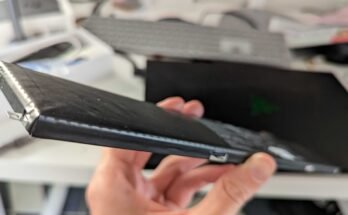Your laptop may be dying while plugged in due to a faulty power adapter or a damaged battery. These issues can prevent your laptop from receiving a steady power supply, causing it to shut down unexpectedly.
As a laptop user, experiencing your device dying while plugged in can be frustrating and disrupt your productivity. Understanding the reasons behind this issue can help you troubleshoot and resolve the problem effectively. We will explore potential causes for your laptop dying despite being connected to a power source.
We will also provide practical tips and solutions for troubleshooting the issue. By the end, you will have a clearer understanding of what may be causing the problem and how to address it, ensuring that your laptop remains reliably powered at all times.

Credit: www.amazon.com
Common Reasons For Laptop Battery Drain
One common reason for laptop battery drain is a faulty adapter that fails to charge the laptop properly, causing it to die even when plugged in. Another possibility is a battery that has reached the end of its lifespan and needs to be replaced in order to resolve the issue.
Common Reasons for Laptop Battery Drain Power-Hungry Applications Power-hungry applications running in the background can lead to excessive battery drain, especially when the laptop is plugged in. These applications, often unnoticed by users, can consume a significant amount of power, impacting the overall battery life. Closing such applications can significantly reduce the drain on the laptop battery. Hardware Issues Hardware issues, such as a faulty charging port or a malfunctioning power management system, can cause the laptop battery to drain rapidly even when the laptop is plugged in. These issues can prevent the proper charging of the battery, leading to continuous drain despite being connected to a power source. Malware or Virus Infection Malware or virus infections can disrupt the normal operation of a laptop, causing excessive resource usage which can lead to significant battery drain. It is essential to regularly scan the laptop for malware and viruses to prevent such issues and ensure the efficient utilization of the battery power. Battery Degradation Over time, laptop batteries degrade, resulting in reduced capacity and increased susceptibility to rapid drain. Even when the laptop is plugged in, the degraded battery may struggle to hold a charge, leading to premature drain. Regular replacement or maintenance of the battery is crucial to mitigate this issue and ensure reliable performance. In summary, understanding the common reasons for laptop battery drain when plugged in is essential in diagnosing and resolving the issue effectively. By addressing power-hungry applications, hardware issues, malware or virus infection, and battery degradation, users can optimize their laptop’s battery performance and prolong its lifespan. Code: “`htmlPower-hungry Applications
Power-hungry applications running in the background can lead to excessive battery drain, especially when the laptop is plugged in. These applications, often unnoticed by users, can consume a significant amount of power, impacting the overall battery life. Closing such applications can significantly reduce the drain on the laptop battery.
Hardware Issues
Hardware issues, such as a faulty charging port or a malfunctioning power management system, can cause the laptop battery to drain rapidly even when the laptop is plugged in. These issues can prevent the proper charging of the battery, leading to continuous drain despite being connected to a power source.
Malware Or Virus Infection
Malware or virus infections can disrupt the normal operation of a laptop, causing excessive resource usage which can lead to significant battery drain. It is essential to regularly scan the laptop for malware and viruses to prevent such issues and ensure the efficient utilization of the battery power.
Battery Degradation
Over time, laptop batteries degrade, resulting in reduced capacity and increased susceptibility to rapid drain. Even when the laptop is plugged in, the degraded battery may struggle to hold a charge, leading to premature drain. Regular replacement or maintenance of the battery is crucial to mitigate this issue and ensure reliable performance.
“` This format allows for an easy integration into WordPress, providing valuable content in an easy-to-read and SEO-friendly manner.
Credit: www.umc.edu
Identifying Power-hungry Applications
When your laptop dies while plugged in, it can be frustrating and inconvenient. One common reason for this issue is power-hungry applications that drain the battery faster than it can be charged. Identifying these applications is crucial for preserving your laptop’s battery life and preventing unexpected shutdowns.
Checking Task Manager
To identify power-hungry applications, open the Task Manager by pressing Ctrl + Shift + Esc. Look for applications and processes with high CPU or memory usage, as these can drain the battery quickly. Sort the list by CPU or memory usage to identify the most resource-intensive applications.
Disabling Startup Programs
Many power-hungry applications launch automatically when you start your laptop, consuming battery power from the outset. By disabling unnecessary startup programs, you can conserve battery life. To do this, open the Task Manager and navigate to the Startup tab. Right-click on the programs you want to disable and select Disable.
Optimizing Application Settings
Some applications have settings that allow you to optimize their performance to reduce battery consumption. For example, video playback and gaming applications often have options to lower graphics quality or limit frame rates, which can significantly reduce power usage. Explore the settings of specific applications to find options for optimizing power consumption.
Addressing Hardware Issues
If you find yourself facing the frustrating situation of your laptop dying while plugged in, it’s likely that a hardware issue is causing the problem. By addressing these hardware issues, you can get your laptop back up and running smoothly. In this article, we’ll explore two key steps to tackle hardware issues: inspecting the power cable and adapter, and replacing faulty components.
Inspecting Power Cable And Adapter
Frequently, the root cause of this problem lies with a faulty power cable or adapter. To identify and resolve these issues, follow the steps below:
- Check the power cable for any visible signs of damage, such as fraying or exposed wires.
- Ensure that the cable is plugged securely into both the laptop and the power outlet.
- Try using a different power outlet to rule out electrical issues.
- If possible, try using a different power adapter to eliminate the possibility of a faulty adapter.
- Consider using a surge protector to safeguard against power fluctuations.
Replacing Faulty Components
If inspecting the power cable and adapter doesn’t solve the problem, it may be necessary to replace faulty internal components. Here are a few potential culprits:
| Potential Faulty Components | How to Replace |
|---|---|
| Battery | Order a new battery from the laptop manufacturer or authorized retailer, following the manufacturer’s instructions to replace it correctly. |
| Charging port | Consult a professional technician to replace the charging port, as it requires technical expertise and may involve soldering. |
| Power supply unit | Contact the laptop manufacturer or authorized service center to obtain a replacement power supply unit. |
| Motherboard | Get assistance from a professional technician as replacing the motherboard is a complex task that requires specialized knowledge. |
Remember to always take appropriate precautions and consult professionals when in doubt, as opening up and replacing internal components can be risky if done improperly.

Credit: www.bobvila.com
Dealing With Malware Or Virus Infection
If your laptop is dying while plugged in, it might be due to a malware or virus infection. These malicious programs can consume your laptop’s resources, drain its battery, and slow down its performance. To resolve this issue, follow these steps:
Running Antivirus Software
The first step in dealing with a malware or virus infection is to run antivirus software. A reliable antivirus program can detect and eliminate any harmful software that might be running in the background.
To start, open your preferred antivirus software and follow the instructions to initiate a full system scan. The antivirus software will search your laptop’s files, programs, and processes for any suspicious activity.
Scanning For Malware
In addition to running antivirus software, it’s also beneficial to conduct a separate malware scan. Malware often differs from traditional viruses and can go undetected by antivirus programs. Thus, a dedicated malware scan can identify and remove these hidden threats.
There are several reliable malware scanning tools available online. You can search for reputable ones and download them from trusted sources. Once downloaded, run the tool and follow the instructions to scan your laptop thoroughly.
Removing Suspicious Programs
If your antivirus and malware scans detect any suspicious programs, it’s crucial to remove them promptly. Sometimes, malware or viruses disguise themselves as legitimate software, so be cautious while reviewing the scan results.
To remove suspicious programs, access your laptop’s control panel and navigate to the “Programs” or “Apps” section. Locate the suspicious program within the list, select it, and choose the option to uninstall/remove.
Once the program is successfully removed, restart your laptop to ensure any remaining traces are eliminated.
By following these steps, you can effectively deal with a malware or virus infection that may be contributing to your laptop’s battery drainage. Remember to regularly update your antivirus software and perform system scans to prevent future infections and ensure the smooth operation of your laptop.
Managing Battery Degradation
One of the most frustrating issues laptop users face is unexpectedly losing battery life even when their laptop is plugged in. This problem can be especially bothersome when you’re in the middle of an important task and your laptop suddenly shuts down. If you’ve experienced this issue, you’re not alone. Many laptop users have encountered the same problem, and it often stems from battery degradation. In this article, we’ll explore how you can effectively manage battery degradation and prevent your laptop from dying while plugged in. By following the simple steps outlined below, you can help extend the lifespan of your laptop battery and ensure a reliable computing experience.
Calibrating The Battery
To begin managing battery degradation, it’s important to calibrate your laptop battery. Battery calibration involves fully charging your battery, allowing it to drain completely, and then recharging it to its full capacity. This process helps your laptop accurately gauge the remaining battery life and prevents inaccurate readings that may cause your laptop to die while plugged in. Here’s a step-by-step guide on how to calibrate your laptop battery:
- Fully charge your laptop battery by keeping it plugged in until the battery indicator shows 100%.
- Once fully charged, disconnect the power adapter and use your laptop as normal until the battery drains and your laptop shuts down.
- After your laptop has completely turned off, reconnect the power adapter and leave it plugged in until the battery is fully charged again.
By calibrating your battery at regular intervals, such as every few months, you can help maintain its accuracy and avoid unexpected shutdowns while your laptop is plugged in.
Optimizing Power Settings
In addition to calibrating the battery, optimizing your laptop’s power settings can also help manage battery degradation. By adjusting power settings, you can customize how your laptop utilizes energy, ensuring it’s not wasting battery life unnecessarily. Here are some power settings you can tweak to improve battery performance:
- Adjust screen brightness: Lowering the screen brightness can significantly reduce battery consumption.
- Manage background apps: Close any unnecessary applications running in the background to minimize battery drain.
- Enable power-saving mode: Activate the power-saving mode feature on your laptop, which limits system performance to conserve battery life.
- Configure sleep and hibernate settings: Adjust the sleep and hibernate settings to activate when your laptop is inactive for a certain period. This helps save battery power when not in use.
By optimizing your laptop’s power settings, you can maximize battery life and prevent your laptop from dying while plugged in.
Recalibrating The Power Management System
If you have followed the above steps and are still experiencing issues with your laptop dying while plugged in, it may be necessary to recalibrate the power management system. This system controls how your laptop uses power and manages the charging and discharging processes. To recalibrate it, you can perform a power cycle on your laptop by following these steps:
- Shut down your laptop and disconnect the power adapter.
- Remove the battery from your laptop.
- Hold down the power button for 15 seconds to drain any remaining power from the laptop.
- Reinsert the battery and reconnect the power adapter.
- Power on your laptop and allow it to fully boot up.
Recalibrating the power management system can help resolve any underlying issues that may be causing your laptop to die while plugged in.
By following these effective strategies for managing battery degradation, you can significantly improve the performance and lifespan of your laptop battery. Remember to calibrate your battery, optimize power settings, and consider recalibrating the power management system if necessary. With these steps in place, you can avoid the frustrations of a dying laptop while plugged in, allowing you to focus on your tasks with peace of mind.
Frequently Asked Questions On Why Is My Laptop Dying While Plugged In
Why Is My Laptop Not Charging When Plugged In?
There could be several reasons why your laptop is not charging when plugged in. It could be due to a faulty power adapter, a loose connection, or a dead battery. It’s recommended to check the charging cable, try a different power outlet, and if the problem persists, consult a professional technician.
What Should I Do If My Laptop Battery Is Not Holding A Charge?
If your laptop battery is not holding a charge, try recalibrating it by draining the battery completely and then fully charging it again. If that doesn’t work, you might need to replace the battery, as it could be reaching the end of its lifespan.
Consult your laptop’s user manual or contact the manufacturer for specific instructions.
Why Does My Laptop Die Even When It’s Plugged In?
If your laptop dies even when it’s plugged in, it can be due to a faulty power adapter, a loose connection, or a problem with the charging port. Check the power adapter and cable for any damage, ensure it’s properly plugged in, and try a different outlet.
If the issue persists, it’s best to seek professional help to diagnose and fix the problem.
Can A Bad Battery Cause A Laptop To Shut Down?
Yes, a bad battery can cause a laptop to shut down unexpectedly. If the battery is no longer holding a charge or has a low capacity, it may not provide enough power to keep the laptop running. In such cases, the laptop may shut down abruptly when the battery drains.
It’s recommended to replace the battery in such situations.
Conclusion
Ultimately, if your laptop is dying even when it’s plugged in, it could be due to a variety of factors. Understanding and addressing these issues is crucial for preserving the functionality and lifespan of your device. From checking the power adapter and cable to examining battery health, troubleshooting the root cause will help you find the necessary solution.
Taking proactive steps now can prevent further frustration and ensure smooth laptop performance in the long run. [46 words]



